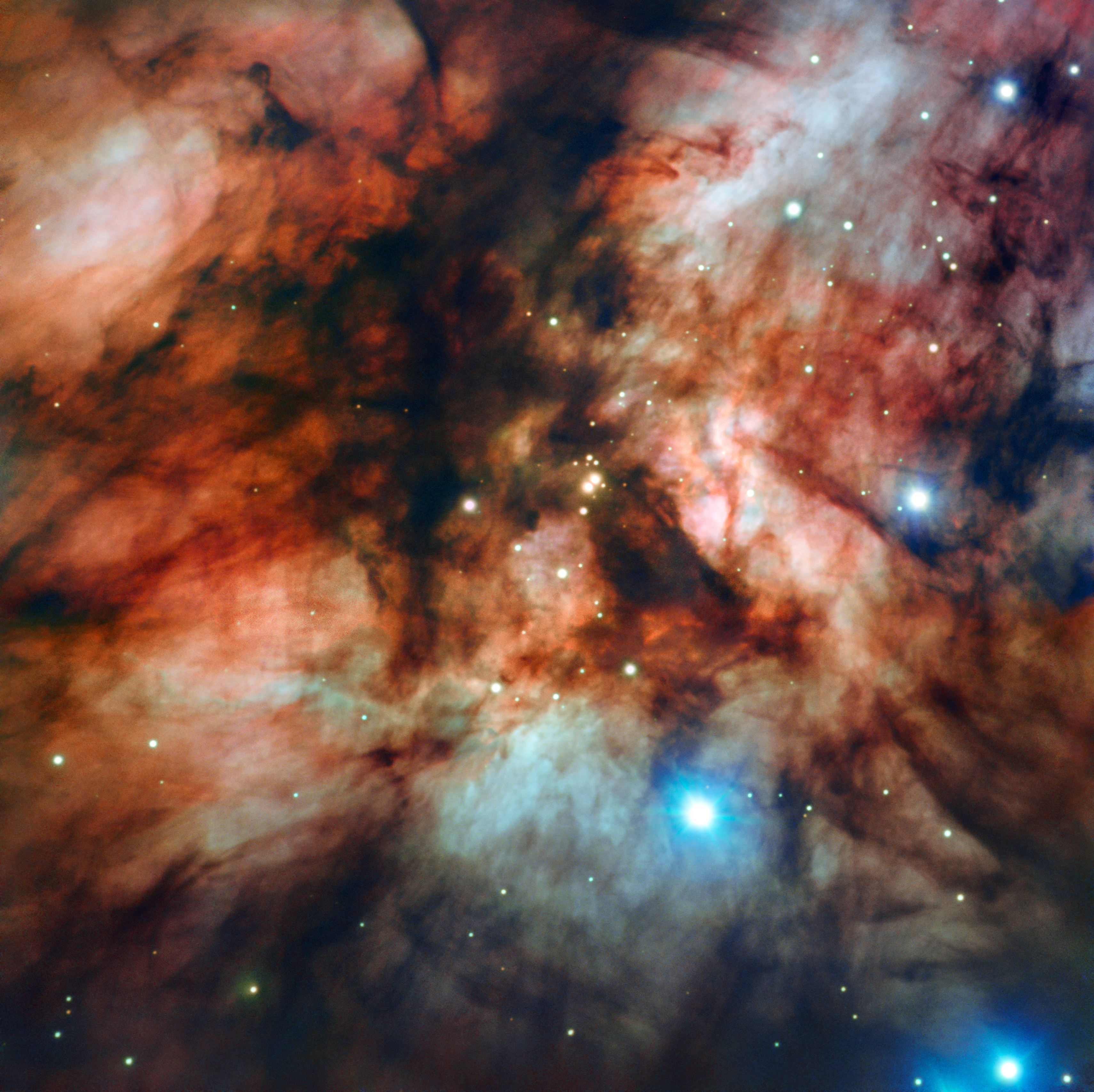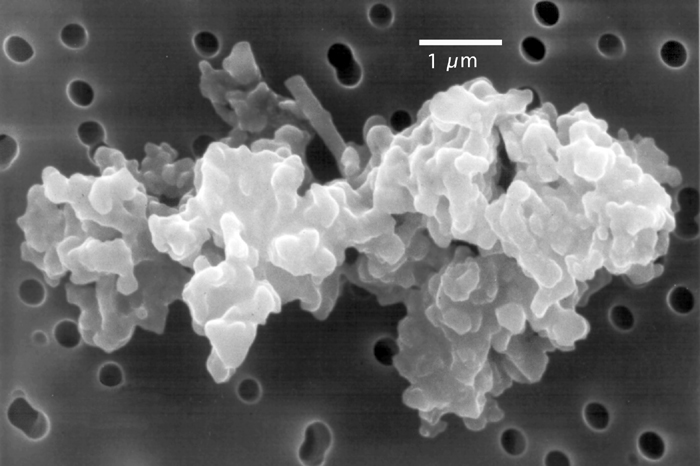|
RCW 36
RCW 36 (also designated Gum 20) is an emission nebula containing an open cluster in the constellation Vela. This H II region is part of a larger-scale star-forming complex known as the Vela Molecular Ridge (VMR), a collection of molecular clouds in the Milky Way that contain multiple sites of ongoing star-formation activity. The VMR is made up of several distinct clouds, and RCW 36 is embedded in the VMR Cloud C. RCW 36 is one of the sites of massive-star formation closest to the Solar System, whose distance of approximately 700 parsecs (2300 light-years). The most massive stars in the star cluster are two stars with late-O or early-B spectral types, but the cluster also contains hundreds of lower-mass stars. This region is also home to objects with Herbig–Haro jets, HH 1042 and HH 1043. Star formation in RCW 36 Like most star-forming regions, the interstellar medium around RCW 36 contains both the gas from which stars form and some newly formed young stars. Here, young st ... [...More Info...] [...Related Items...] OR: [Wikipedia] [Google] [Baidu] |
J2000
In astronomy, an epoch or reference epoch is a moment in time used as a reference point for some time-varying astronomical quantity. It is useful for the celestial coordinates or orbital elements of a celestial body, as they are subject to perturbations and vary with time. These time-varying astronomical quantities might include, for example, the mean longitude or mean anomaly of a body, the node of its orbit relative to a reference plane, the direction of the apogee or aphelion of its orbit, or the size of the major axis of its orbit. The main use of astronomical quantities specified in this way is to calculate other relevant parameters of motion, in order to predict future positions and velocities. The applied tools of the disciplines of celestial mechanics or its subfield orbital mechanics (for predicting orbital paths and positions for bodies in motion under the gravitational effects of other bodies) can be used to generate an ephemeris, a table of values giving the positions ... [...More Info...] [...Related Items...] OR: [Wikipedia] [Google] [Baidu] |
Herbig–Haro Object
Herbig–Haro (HH) objects are bright patches of nebulosity associated with newborn stars. They are formed when narrow jets of partially ionised gas ejected by stars collide with nearby clouds of gas and dust at several hundred kilometres per second. Herbig–Haro objects are commonly found in star-forming regions, and several are often seen around a single star, aligned with its rotational axis. Most of them lie within about one parsec (3.26 light-years) of the source, although some have been observed several parsecs away. HH objects are transient phenomena that last around a few tens of thousands of years. They can change visibly over timescales of a few years as they move rapidly away from their parent star into the gas clouds of interstellar space (the interstellar medium or ISM). Hubble Space Telescope observations have revealed the complex evolution of HH objects over the period of a few years, as parts of the nebula fade while others brighten as they collide with the clu ... [...More Info...] [...Related Items...] OR: [Wikipedia] [Google] [Baidu] |
Mass Of The Sun
The solar mass () is a standard unit of mass in astronomy, equal to approximately . It is often used to indicate the masses of other stars, as well as stellar clusters, nebulae, galaxies and black holes. It is approximately equal to the mass of the Sun. This equates to about two nonillion ( short scale), two quintillion (long scale) kilograms or 2000 quettagrams: The solar mass is about times the mass of Earth (), or times the mass of Jupiter (). History of measurement The value of the gravitational constant was first derived from measurements that were made by Henry Cavendish in 1798 with a torsion balance. The value he obtained differs by only 1% from the modern value, but was not as precise. The diurnal parallax of the Sun was accurately measured during the transits of Venus in 1761 and 1769, yielding a value of (9 arcseconds, compared to the present value of ). From the value of the diurnal parallax, one can determine the distance to the Sun from the geometry ... [...More Info...] [...Related Items...] OR: [Wikipedia] [Google] [Baidu] |
NANTEN2 Observatory
The NANTEN2 Observatory is a southern sky observatory in the Atacama Desert of northern Chile. It is located at an altitude of on Pampa la Bola next to Cerro Chajnantor. The observatory is equipped with a millimeter and submillimeter wave telescope that is used for southern sky observations of atomic and molecular spectral lines in 110 GHz to 880 GHz range. It is one of a number of observatories operating at Llano de Chajnantor Observatory. It is operated as a collaboration between research institutes in Japan (Nagoya University and Osaka University), South Korea (Seoul National University), Germany (KOSMA, Universität zu Köln, Argelander Institute for Astronomy at the University of Bonn), Australia (University of New South Wales, University of Adelaide, Macquarie University, Swinburne University of Technology, University of Sydney, University of Western Sydney) and Chile (Universidad de Chile). The instrument was previously located at the Las Campanas Observatory from 1995 ... [...More Info...] [...Related Items...] OR: [Wikipedia] [Google] [Baidu] |
Formaldehyde
Formaldehyde ( , ) ( systematic name methanal) is a naturally occurring organic compound with the formula and structure . The pure compound is a pungent, colourless gas that polymerises spontaneously into paraformaldehyde (refer to section Forms below), hence it is stored as an aqueous solution (formalin), which is also used to store animal specimens. It is the simplest of the aldehydes (). The common name of this substance comes from its similarity and relation to formic acid. Formaldehyde is an important precursor to many other materials and chemical compounds. In 1996, the installed capacity for the production of formaldehyde was estimated at 8.7 million tons per year. It is mainly used in the production of industrial resins, e.g., for particle board and coatings. Forms Formaldehyde is more complicated than many simple carbon compounds in that it adopts several diverse forms. These compounds can often be used interchangeably and can be interconverted. *Molecular for ... [...More Info...] [...Related Items...] OR: [Wikipedia] [Google] [Baidu] |
Hydroxyl Radical
The hydroxyl radical is the diatomic molecule . The hydroxyl radical is very stable as a dilute gas, but it decays very rapidly in the condensed phase. It is pervasive in some situations. Most notably the hydroxyl radicals are produced from the decomposition of hydroperoxides (ROOH) or, in atmospheric chemistry, by the reaction of excited atomic oxygen with water. It is also important in the field of radiation chemistry, since it leads to the formation of hydrogen peroxide and oxygen, which can enhance corrosion and SCC in coolant systems subjected to radioactive environments. In organic synthesis, hydroxyl radicals are most commonly generated by photolysis of 1-hydroxy-2(1''H'')-pyridinethione. Notation The unpaired electron of the hydroxyl radical is officially represented by a middle dot, •, beside the O. Biology Hydroxyl radicals can occasionally be produced as a byproduct of immune action. Macrophages and microglia most frequently generate this compound wh ... [...More Info...] [...Related Items...] OR: [Wikipedia] [Google] [Baidu] |
Carbon Monoxide
Carbon monoxide ( chemical formula CO) is a colorless, poisonous, odorless, tasteless, flammable gas that is slightly less dense than air. Carbon monoxide consists of one carbon atom and one oxygen atom connected by a triple bond. It is the simplest molecule of the oxocarbon family. In coordination complexes the carbon monoxide ligand is called carbonyl. It is a key ingredient in many processes in industrial chemistry. The most common source of carbon monoxide is the partial combustion of carbon-containing compounds, when insufficient oxygen or heat is present to produce carbon dioxide. There are also numerous environmental and biological sources that generate and emit a significant amount of carbon monoxide. It is important in the production of many compounds, including drugs, fragrances, and fuels. Upon emission into the atmosphere, carbon monoxide affects several processes that contribute to climate change. Carbon monoxide has important biological roles across phylog ... [...More Info...] [...Related Items...] OR: [Wikipedia] [Google] [Baidu] |
Radio Telescopes
A radio telescope is a specialized antenna and radio receiver used to detect radio waves from astronomical radio sources in the sky. Radio telescopes are the main observing instrument used in radio astronomy, which studies the radio frequency portion of the electromagnetic spectrum emitted by astronomical objects, just as optical telescopes are the main observing instrument used in traditional optical astronomy which studies the light wave portion of the spectrum coming from astronomical objects. Unlike optical telescopes, radio telescopes can be used in the daytime as well as at night. Since astronomical radio sources such as planets, stars, nebulas and galaxies are very far away, the radio waves coming from them are extremely weak, so radio telescopes require very large antennas to collect enough radio energy to study them, and extremely sensitive receiving equipment. Radio telescopes are typically large parabolic ("dish") antennas similar to those employed in tracking a ... [...More Info...] [...Related Items...] OR: [Wikipedia] [Google] [Baidu] |
RCW 36 Cloudy With A Chance Of Dust , a conflict in R ...
RCW may refer to * Rare Coin Wholesalers * Ramial Chipped Wood * Runtime Callable Wrapper in Microsoft Component Object Model and .NET interoperability * Revolutionary Championship Wrestling, a professional wrestling promotion * RCW Catalogue, an astronomical catalogue * Revised Code of Washington, laws and statutes effective in the jurisdiction of Washington state * Return to Castle Wolfenstein, a video game originally published in 2001 * Red cockaded woodpecker, an endangered woodpecker native to the southeastern United States. * Riot City Wrestling, a professional wrestling promotion * Russian Civil War, a civil war that took place between 1918–20 following the 1917 Russian Revolution * Rwandan Civil War The Rwandan Civil War was a large-scale civil war in Rwanda which was fought between the Rwandan Armed Forces, representing the country's government, and the rebel Rwandan Patriotic Front (RPF) from 1October 1990 to 18 July 1994. The war aro ... [...More Info...] [...Related Items...] OR: [Wikipedia] [Google] [Baidu] |
Jeans Instability
In stellar physics, the Jeans instability causes the collapse of interstellar gas clouds and subsequent star formation, named after James Jeans. It occurs when the internal gas pressure is not strong enough to prevent gravitational collapse of a region filled with matter. For stability, the cloud must be in hydrostatic equilibrium, which in case of a spherical cloud translates to: :\frac = -\frac, where M_\text(r) is the enclosed mass, p is the pressure, \rho(r) is the density of the gas (at radius r), G is the gravitational constant, and r is the radius. The equilibrium is stable if small perturbations are damped and unstable if they are amplified. In general, the cloud is unstable if it is either very massive at a given temperature or very cool at a given mass; under these circumstances, the gas pressure cannot overcome gravity, and the cloud will collapse. The Jeans instability likely determines when star formation occurs in molecular clouds. Jeans mass The Jeans mass is ... [...More Info...] [...Related Items...] OR: [Wikipedia] [Google] [Baidu] |
Cosmic Dust
Cosmic dust, also called extraterrestrial dust, star dust or space dust, is dust which exists in outer space, or has fallen on Earth. Most cosmic dust particles measure between a few molecules and 0.1 mm (100 micrometers). Larger particles are called meteoroids. Cosmic dust can be further distinguished by its astronomical location: intergalactic dust, interstellar dust, interplanetary dust (such as in the zodiacal cloud) and circumplanetary dust (such as in a planetary ring). There are several methods to obtain space dust measurement. In the Solar System, interplanetary dust causes the zodiacal light. Solar System dust includes comet dust, asteroidal dust, dust from the Kuiper belt, and interstellar dust passing through the Solar System. Thousands of tons of cosmic dust are estimated to reach the Earth's surface every year, [...More Info...] [...Related Items...] OR: [Wikipedia] [Google] [Baidu] |





